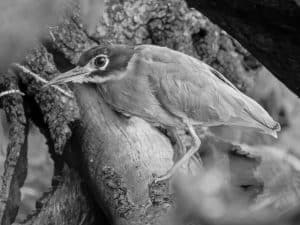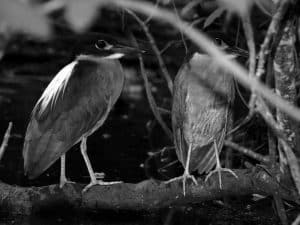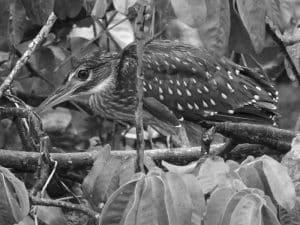Introduction to the White-Backed Night-Heron
Welcome to the fascinating world of the White-Backed Night-Heron, a stunning avian species that calls Tanzania its home. This enigmatic bird, scientifically known as Gorsachius leuconotus, is a sight to behold with its distinct white back and secretive nature. The White-Backed Night-Heron in Tanzania is a rare gem in the avian kingdom, captivating birdwatchers and nature enthusiasts with its elusive presence. In this comprehensive guide, we will delve into the habitat, behavior, conservation status, and unique characteristics of the White-Backed Night-Heron, providing you with valuable insights into this captivating species.

The White-Backed Night-Heron is predominantly found in the lush woodlands, swamps, and riverine habitats of Tanzania. This stunning bird’s distribution spans across the eastern and southern regions of the country, encompassing a variety of ecosystems that offer the ideal conditions for its survival. From the dense foliage of the coastal forests to the serene wetlands of the Rufiji River Basin, the White-Backed Night-Heron’s habitat is as diverse as it is captivating. As we explore further, you will gain a deeper understanding of the specific locations where this elusive bird can be spotted, enriching your birdwatching experiences in Tanzania.
Habitat and Distribution of the White-Backed Night-Heron in Tanzania
The White-Backed Night-Heron’s habitat and distribution in Tanzania are a testament to the bird’s adaptability to diverse environments. This elusive species is known to inhabit the dense mangroves along the coastal regions, where its cryptic plumage allows it to blend seamlessly with the surrounding foliage. Additionally, the White-Backed Night-Heron can be found in the tranquil wetlands and marshy areas, where its hunting prowess is put to the test as it seeks out its preferred prey. The bird’s distribution extends into the interior woodlands, where it seeks refuge in the thick undergrowth, evading the prying eyes of predators and human observers alike.
Despite its widespread presence in Tanzania, the White-Backed Night-Heron remains a relatively uncommon sight, adding to its allure for birdwatchers and nature enthusiasts. The bird’s distribution is intricately linked to the availability of suitable habitats, making it an indicator species for the health of the ecosystems it calls home. As we delve deeper into the behavior and diet of the White-Backed Night-Heron, you will uncover the intricate relationship between this captivating bird and its natural surroundings, gaining valuable insights into its role in the Tanzanian ecosystem.
Behavior and Diet of the White-Backed Night-Heron
The behavior of the White-Backed Night-Heron is shrouded in mystery, owing to its nocturnal habits and elusive nature. This enigmatic bird is primarily active during the twilight hours, venturing out under the cover of darkness to engage in its nocturnal pursuits. The White-Backed Night-Heron’s stealthy demeanor and solitary nature make it a challenging yet rewarding subject for birdwatchers, offering glimpses into its secretive life as it navigates the twilight realm with unparalleled grace.
In addition to its elusive behavior, the White-Backed Night-Heron’s diet adds to its mystique, as it is a proficient hunter with a preference for aquatic prey. Small fish, amphibians, and invertebrates form the core of the bird’s diet, and its specialized hunting techniques are a testament to its adaptability in capturing elusive quarry. As we explore the bird’s feeding habits, you will gain a deeper appreciation for the White-Backed Night-Heron’s role as a top predator in its habitat, contributing to the delicate balance of the Tanzanian ecosystems it inhabits.
Conservation Status and Threats Faced by the White-Backed Night-Heron
The White-Backed Night-Heron’s conservation status in Tanzania reflects the challenges faced by many elusive and specialized avian species. While the bird’s habitat remains relatively intact in select regions, the growing pressures of habitat loss, degradation, and human disturbance pose significant threats to its long-term survival. The White-Backed Night-Heron’s elusive nature and specific habitat requirements make it particularly vulnerable to the impacts of human activities, highlighting the urgent need for conservation efforts to safeguard its future.
Despite its status as a rare and elusive species, the White-Backed Night-Heron’s conservation remains a critical priority for the preservation of Tanzania’s rich avian diversity. As we delve into the best locations for birdwatching the White-Backed Night-Heron in Tanzania, you will gain valuable insights into the specific habitats and ecosystems that are vital for the bird’s survival, empowering you to contribute to its conservation through responsible and informed birdwatching practices.
Best Locations for Birdwatching the White-Backed Night-Heron in Tanzania

Tanzania is a treasure trove for birdwatchers, offering a myriad of habitats and ecosystems where the White-Backed Night-Heron can be observed in its natural environment. From the coastal mangroves of the Rufiji Delta to the tranquil wetlands of the Kilombero Valley, there are several prime locations where birdwatchers can immerse themselves in the captivating world of the White-Backed Night-Heron. As we uncover these best locations, you will gain invaluable insights into the diverse landscapes that play host to this elusive bird, enhancing your birdwatching experiences in Tanzania.
The Rufiji River Basin, with its expansive wetlands and labyrinth of channels, serves as a haven for the White-Backed Night-Heron, offering unparalleled opportunities for birdwatchers to observe this elusive species. The bird’s presence in the coastal mangroves adds to the allure of the Rufiji Delta, where its cryptic plumage and secretive nature make spotting it a rewarding challenge. Additionally, the tranquil wetlands of the Kilombero Valley provide a serene backdrop for birdwatching, allowing enthusiasts to witness the White-Backed Night-Heron in its element as it navigates the marshy habitats in search of prey.
Tips for Spotting the White-Backed Night-Heron
Spotting the elusive White-Backed Night-Heron requires patience, perseverance, and a keen eye for detail. As a stealthy nocturnal bird, the White-Backed Night-Heron is adept at blending into its surroundings, making it a challenging yet rewarding subject for birdwatchers. To increase your chances of spotting this enigmatic species, consider visiting its preferred habitats during the twilight hours, when the bird is most active and likely to emerge from its concealed roosting spots.
When venturing out to observe the White-Backed Night-Heron, be mindful of minimizing disturbances to its habitat and fellow wildlife. Respect the natural rhythms of the ecosystems you visit, and practice responsible birdwatching by adhering to designated trails and viewing areas. By treading lightly and minimizing your impact, you can enhance the likelihood of encountering the White-Backed Night-Heron in its natural environment, fostering a harmonious coexistence between humans and wildlife.
Unique Characteristics and Adaptations of the White-Backed Night-Heron
The White-Backed Night-Heron’s unique characteristics and adaptations set it apart as a captivating species with a rich evolutionary history. From its cryptic plumage to its stealthy hunting prowess, this enigmatic bird is a marvel of nature, showcasing a suite of adaptations that have shaped its survival in the Tanzanian ecosystems. The bird’s striking white back, contrasted by its dusky wings and intricate patterning, serves as a visual testament to its elegance and resilience in the face of environmental challenges.
In addition to its visual allure, the White-Backed Night-Heron possesses specialized adaptations for its nocturnal lifestyle and hunting strategies. Its keen eyesight and acute hearing allow it to navigate the dimly lit environments of the twilight hours, honing in on the movements of its aquatic prey with remarkable precision. Furthermore, the bird’s slender build and agile movements make it a formidable hunter, adept at capturing elusive quarry in the watery realms it frequents. As we delve deeper into the unique characteristics and adaptations of the White-Backed Night-Heron, you will gain a newfound appreciation for the intricate interplay between form and function in the evolution of this captivating avian species.
The Importance of Protecting the White-Backed Night-Heron’s Habitat
The preservation of the White-Backed Night-Heron’s habitat is crucial for the long-term survival of this rare and elusive species. The diverse ecosystems that the bird inhabits play a vital role in supporting its unique life history, from the coastal mangroves to the inland wetlands and woodlands of Tanzania. By safeguarding these habitats, we not only protect the White-Backed Night-Heron, but also contribute to the conservation of a myriad of other wildlife species that rely on these ecosystems for their survival.
The coastal mangroves, with their intricate network of roots and channels, serve as essential nurseries for a variety of marine and avian species, including the White-Backed Night-Heron. These ecosystems provide critical breeding and foraging grounds, supporting the intricate web of life that sustains the bird and its fellow inhabitants. Additionally, the inland wetlands and woodlands offer vital refuges for the White-Backed Night-Heron, providing sanctuary from the pressures of human development and habitat alteration.
Efforts and Initiatives for White-Backed Night-Heron Conservation in Tanzania

In response to the conservation challenges faced by the White-Backed Night-Heron, a range of efforts and initiatives have been undertaken to protect this rare avian species in Tanzania. Conservation organizations, research institutions, and local communities have collaborated to implement measures aimed at safeguarding the bird’s habitat, raising awareness about its conservation needs, and conducting research to better understand its ecological requirements. These concerted efforts have yielded valuable insights into the White-Backed Night-Heron’s distribution, behavior, and conservation status, informing targeted conservation actions to secure its future.
One such initiative focuses on the monitoring and protection of the White-Backed Night-Heron’s key habitats, employing strategies to mitigate the impacts of habitat loss, degradation, and human disturbance. By engaging local communities and stakeholders in conservation efforts, these initiatives foster a sense of stewardship for the bird’s habitats, promoting sustainable practices that benefit both wildlife and people. Furthermore, educational programs and outreach activities raise awareness about the White-Backed Night-Heron and its conservation significance, inspiring a collective commitment to safeguarding this rare and enigmatic species.
Conclusion
In conclusion, the White-Backed Night-Heron stands as a captivating symbol of Tanzania’s rich avian diversity, captivating birdwatchers and nature enthusiasts with its elusive presence and unique adaptations. As we have explored the bird’s habitat, behavior, conservation status, and the efforts aimed at safeguarding its future, it is evident that the conservation of this rare species is a shared responsibility that requires collective action and stewardship.


































